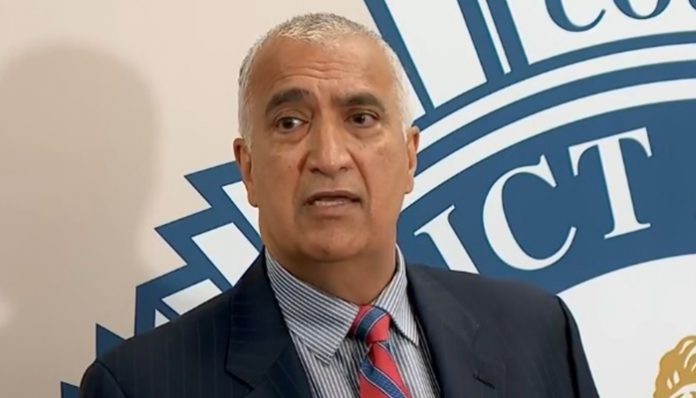SALT LAKE CITY, Utah, Aug. 28, 2020 (Gephardt Daily) — Salt Lake County District Attorney Sim Gill has ruled that the police fatal shooting of a Millcreek man on Feb. 3 of this year was justified because the officers had reason to believe their lives were at risk.
The six Unified Police officers who fired on Marc Dominic Neal, 57, will not be prosecuted in the case, Gill said.
Neal had raised what appeared to be a handgun at officers after being told many times to drop the weapon, Gill said, playing a blurry shot from a distance. Because it was cold and snowing, most officer’s body cameras were blocked by their jackets, and only recorded audio to be reviewed.
One officer had his jacket open, which provided the lone, blurry video shown to reporters Friday at a news conference called by Gill.
It was only after a second round of shots, when someone said Neal still had the gun and was raising it, that police felt safe to approach a motionless Neal. It was then determined that Neal, by then deceased, had been holding a fake gun, made to look realistic and weighted to handle like a real gun.
Gill also cited information offered by Neal’s mother and stepfather, who said he was out of control and allegedly high on drugs. Gill said even Neal’s stepfather believed the gun was real.
Gill said officers attempted to deescalate the situation, and were too far from Neal to use a Taser when it appeared Neal was threatening officers by raising what appeared to be a lethal weapon. An officer with a bean-bag type gun was on route, but had not arrived, Gil said.
Neal, who had been released from probation in 2019 for an earlier conviction, also told officers he was not going back to jail, Gill said. Neal also picked out an officer, indicating he would be “first,” which officers believed meant the officer would be the first shot.
Asked by a reporter what could be done when a mentally ill or high suspect set up the situation for a “suicide by cop,” Gill praised the question, saying that over the past decade when he had been deciding cases, he had noticed that mental health issues and criminal acts intersected more frequently.
“I think we need to be cognizant that there are individuals in our community, especially if they’re interacting with law enforcement, that’s something we absolutely need to be more invested in.
“I think we do a very poor job — that’s my opinion — we do a very poor job in addressing that subset of the population that is intersected with the criminal justice system…. I think we need to do a much more invested interaction.
“Having said that, our best efforts may not absolve us from what is presented, which is what looks like a real gun that’s there. So this tragedy, this shooting is absolutely tragic in the sense that you have somebody who may have mental-health compromise, who may be on drugs, but at the same time, I’ve got officers who are responding to what they believe to be an actual domestic situation where the persons who are reporting are saying its a real gun, and there’s nothing to indicate to them it’s not.
“Even though they are aware of his mental illness, they are responding to what he does.”
Gill said mental health issues are often a factor in shooting reviews.
“But at the same time, I have to look at the context of the decision when an officer makes that decision. And in that context, these are the facts.”






